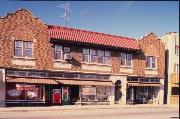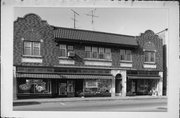Property Record
112-114 N WATER ST
Architecture and History Inventory
| Historic Name: | George's Pharmacy |
|---|---|
| Other Name: | Ben Franklin/The Beautique |
| Contributing: | Yes |
| Reference Number: | 27980 |
| Location (Address): | 112-114 N WATER ST |
|---|---|
| County: | Monroe |
| City: | Sparta |
| Township/Village: | |
| Unincorporated Community: | |
| Town: | |
| Range: | |
| Direction: | |
| Section: | |
| Quarter Section: | |
| Quarter/Quarter Section: |
| Year Built: | 1930 |
|---|---|
| Additions: | 1944 |
| Survey Date: | 1989 |
| Historic Use: | retail building |
| Architectural Style: | Spanish/Mediterranean Styles |
| Structural System: | |
| Wall Material: | Brick |
| Architect: | Arnold Construction Company |
| Other Buildings On Site: | |
| Demolished?: | No |
| Demolished Date: |
| National/State Register Listing Name: | Water Street Commercial Historic District |
|---|---|
| National Register Listing Date: | 11/12/1992 |
| State Register Listing Date: | 7/3/1992 |
| National Register Multiple Property Name: |
| Additional Information: | Prior to the George Pharmacy construction at this address over the channel of Beaver Creek, there were no other buildings located at this address. The George Pharmacy was an ancestor of the D.D. Cheney Drugstore, one of three important drugstores that opened for business in Sparta in the early 20th century. In 1919, Otis Franklin George purchased the drugstore owned by D.D. Cheney and continued its operation until 1930, when he moved the drugstore to its present location. It is not known how long the George Pharmacy operated at this address. The George Pharmacy gains local historical significance under Criterion A in association with the Patent Medicine and Drug Industry topic of the Industry Theme. The building's period of significance ranges from its erection in 1930 to an unknown closing date. This two-story Mediterranean Revival styled commercial block is a brick faced building characterized by a red tile pent roof resting on console brackets over the center bays of the facade. The roof is flanked by curvilinear brick gables rising above the roof line on both ends of the facade. Plain rectangular windows on the upper story, which are paired on both ends of the building and arranged in a group of four in the center bay, all with six lights over clear plate glass, further characterize the building. Blind brick arches accented by white masonry keystones and end blocks have tympanums filled with decorative brick work in a basketweave pattern visually resting on inlaid brick pilasters, and ornament the second-story paired windows in the curvilinear gabled end bays. Panels of white masonry accent the full length of the brick facade immediately below the white masonry window sills. The George building, supported by iron eye beams placed on concrete piers [visible form the rear of the building], spans the channel of Beaver Creek. The original double storefront [south storefront used for the drugstore is larger than the north storefront] featuring a full length transom window with lights of art glass in a geometric pattern, checkered glass window aprons and recessed entrances remain on the building. A white masonry rectangular second-floor stairway entrance decorated by pressed curvilinear moldings and keystone with a rectangular door topped by a round arched transom featuring a decorative iron grill is located between the two storefronts. Paneled white masonry pilasters at the ends of the storefront further accent this well preserved Mediterranean styled building. Exhibiting exceptionally well-preserved facade and elevations, the George building's foundation was altered extensively after the flooding of Beaver Creek on May 30, 1943. In negotiations with the State Highway Commission, who were responsible for the replacement of the Water Street bridge over Beaver Creek, the city agreed to remove the basement and support system of the building originally designed to span the creek channel so the channel could be widened to control future flooding, to place the building on steel girders, to rebuild a small basement for the heating plant north of the bridge abutments and to construct a wing dam that was continuous with the building's foundation. The city undertook the work in 1944 with local labor at a total cost not to exceed $25,000 under the direction of an expert hired from Chicago, Frank P. Noe [president of L.P. Friestadt Co., a structural steel erector and moving company]. As necessitated by circumstances, the City temporarily became legal owners of the George building in July 1944. The George Drug Store building, designed by an engineering firm, the Arnold Construction Company of Eau Claire, WI, to span the flood prone Beaver Creek, was constructed in 1930+ on a basement and bridge of reinforced concrete erected on piles several feet above the water line. Built for Otis F. George to house his drug store established and for his personal residence, this business block was described, at the time of its construction, as a brick veneer, asbestos lined building, 60 feet deep with a 68 foot front. It also was reported to have hardwood woodwork and built-in cabinets in the "modern" apartments located on the second floor and hardwood booths for the soda-grill in the drug store. Originally George rented the north store space to the Francis Hutson Clothing Store, a second floor office to Dr. Sutherland and three of the four second floor apartments, reserving the larger one for himself and his family. The George Drug Store is significant under criterion C as an example of the Mediterranean Revival style. The only example of the Mediterranean style in the intensive survey area and in the historic district, the exceptionally well-preserved George Drug Store exhibits the curvilinear gables, red tile roofs, and round arched openings associated with the style. |
|---|---|
| Bibliographic References: | (A) Monroe County Historical Society, Photograph Collection, Photograph #1459. (B) Sparta Herald Feb. 6, 1930; July 31, 1930; Aug. 7, 1930; May 31, 1943; Aug. 2, 1943; Aug. 30, 1943; Oct. 4, 1943; Nov. 15, 1943; March 6, 1944; July 24, 1944. (C) Sanborn Insurance Map 1889, 1894, 1900, 1911, 1922, 1931. (D) City of Sparta Tax Records, 1925-1930. (E) City of Sparta Property Tax Rolls, 1870-1940. (F) City of Sparta: Tour Historical Downtown Sparta. (G) Gregory, John G., West Central Wisconsin: a History. Indianapolis: S.J. Clarke Publishing Company, 1933, Vol. 4, pp. 39-40, 184. |
| Wisconsin Architecture and History Inventory, State Historic Preservation Office, Wisconsin Historical Society, Madison, Wisconsin |


